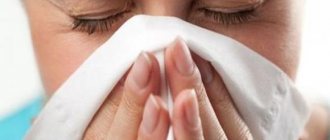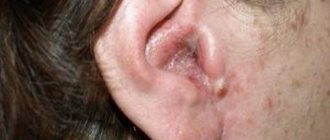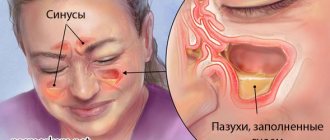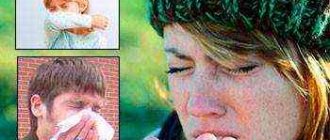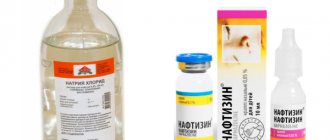Possible ailments
The nature of the mucus in the eyes can determine eye disease. If white discharge periodically occurs in the morning, but there are no symptoms of inflammation, then this is normal. With the regular appearance of mucus and the presence of other complaints, there may be ophthalmological ailments:
- If white mucus comes out of the eyes, this may be a symptom of viral diseases. For example, this happens with viral conjunctivitis. Still white, stretchy mucus is released from the eyes after an acute respiratory viral infection. Redness of the mucous membrane and sclera, lacrimation, photophobia, swelling, and cold symptoms also appear. When the virus occurs, first one visual organ is damaged, and then the second.
- Mucus in the eyes also appears with dry eye syndrome. Dryness and fatigue of the visual organ occur. Appears after long hours of hard work at the computer or with small objects.
- Liquid discharge is considered a symptom of allergies. Usually both eyes are affected. With this phenomenon, severe itching occurs. There is redness of the eyelids and swelling. When the allergen is eliminated, the symptoms subside.
- Liquid transparent discharge occurs from dust and foreign bodies. This is a protective reaction of the body. In this case, it is necessary to remove foreign particles mechanically.
- Yellow, profuse discharge occurs due to inflammation of the lacrimal sac - dacryocystitis. The mucus is thick and abundant. It intensifies when massaging the affected area.
- The appearance of greenish or yellowish foamy discharge is associated with blepharitis - inflammation of the eyelid. This disease causes itching, peeling, and swelling of the eyelids. The discharge is sticky, occurs in the morning, and sticks the eyelashes together. They create dense scales and crusts.
- Thick yellow, green discharge is a symptom of inflammation that appears when white blood cells accumulate. It occurs with bacterial conjunctivitis, viral and fungal infections of the cornea, trachoma, and barley opening. Dense crusts also form, which are difficult to remove. A film appears on the eye, interfering with the clarity of vision. There is redness, swelling, lacrimation, photophobia. In difficult cases, pain in the eyes, headache, and high fever are observed.
- Thread-like discharge appears with filamentous keratitis. This disease occurs when the function of the lacrimal glands is reduced. Dryness, burning, thread-like discharge, and redness of the sclera occur. This causes dystrophic changes in the cornea.
Why does mucus come out of the eyes and accumulate in the corner? The reason is the anatomical structure of the organ of vision. The corner is slightly recessed in the orbit compared to other structures. Therefore, liquid secretions flow there most easily. There is an outlet for the nasolacrimal duct. With its inflammation, pus comes out in the corner.
The child has watery eyes and a runny nose
These symptoms cause the most problems to children and their parents who are concerned about the child’s condition.
Let's list the most common reasons why a child has watery eyes and a runny nose: he has a cold, allergies, adenoiditis, inflammation of the paranasal sinuses or a foreign body in the nose.
To accurately diagnose the problem, you need to know what other symptoms accompany the disease, as well as conduct a thorough examination of the baby and, if necessary, take tests and perform other studies.
If your baby has watery eyes and a runny nose
In infants there is a so-called physiological rhinitis. What does it mean? The baby's nasal passages are narrow, and the nasal cavity secretes mucus to moisturize and protect the mucous membrane.
This mucus accumulates in the nose, dries into crusts and prevents the child from breathing. In this case, there is no temperature, and the little patient is no longer worried about anything.
You can get rid of such mucus and crusts with a special children's aspirator or cotton wool pads soaked in sterile Vaseline.
to the content?
In children
Discharge from the eyes in newborns appears due to dacryocystitis. The cause is obstruction of the nasolacrimal duct, which is associated with its underdevelopment. The baby experiences redness, swelling, and yellow discharge. The child becomes capricious and rubs his eyelids.
For treatment, massage of the lacrimal sac, rinsing with antiseptics, and topical antibiotics are used. If this is ineffective, the nasolacrimal duct is washed with a probe.
In children, discharge from the eyes appears due to bacterial and viral infection. In the first case, the mucus will be yellowish, and in the second, whitish. The child usually cries, becomes lethargic, and scratches his eyes. Treatment is performed by washing with antiseptics, and local antibacterial drugs are prescribed (for bacterial infection). If there are crusts, they are soaked before removal to prevent damage to the skin.
It is normal to have a small amount of white content after sleep. The baby's body protects the eyes from microparticles. Treatment in this case is not required.
Provocateurs of this phenomenon
If a person, when blowing his nose, discovers blood in his snot, then various factors may contribute to this:
- Age-related changes leading to fragility and fragility of blood vessels.
- Lack of potassium, vitamin C and other substances (vitaminosis).
- Hormonal imbalance.
- Habit of picking your nose.
- Genetic predisposition.
- Hypothermia.
- Reduced blood clotting and capillary permeability.
- Injuries.
- Abnormal structure of the nose.
- Use of nasal medications.
- Allergic reactions.
- Polyposis.
- Sinusitis, etc.
Often, the appearance of blood ichor in blown mucus occurs due to exposure to dry air. It negatively affects the circulatory system. And if at the same time a person has fragility of the capillaries, then any mechanical or physical uncontrolled action (for example, sneezing) leads to damage to their integrity, resulting in bleeding.
In this case, no special therapy is required. You just need to maintain an optimal level of air humidity in the room and drink vitamin C, the effect of which is aimed at strengthening the vascular walls and the body’s defenses.
The appearance of such snot often occurs against the background of strong nose blowing, sneezing or picking your nose. These factors provoke an increase in pressure on the capillaries, which leads to damage to their integrity, and the secreted blood comes out of the nose along with mucus. Weakening of blood vessels and their increased fragility can be caused by exposure to low temperatures on the body (for example, prolonged swimming in cold water, the use of ice compresses, etc.).
It is important to distinguish discharge from nosebleeds. The reasons for their appearance are different, and therefore the treatment is different.
If infectious processes occur in the body, allergic reactions or a lack of vitamins and minerals are observed, this also leads to increased fragility of blood vessels. And any impact on them provokes their damage.
Also, the most common causes of a runny nose with blood include long-term use of nasal medications. They not only dry out the nasal mucous membranes, but also lead to weakening of blood vessels. Frequent use of antibiotics thins the blood, resulting in blood impurities in the mucus produced.
Often the provocateurs of this phenomenon are otolaryngological diseases, the development of which is caused by congenital or acquired anomalies of the nose. Against their background, the walls of the capillaries become much thinner, which causes their frequent vulnerability.
In some cases, the appearance of a runny nose with blood is caused by:
- Impaired functionality of cerebral vessels.
- Increased intracranial pressure.
- The formation of benign and malignant tumors in the nasopharynx.
Sinusitis and sinusitis can also cause nasal discharge. As a rule, their occurrence is associated with the long-term development of pathological processes in the axillary cavities and the lack of adequate treatment.
Associated symptoms
In addition to the appearance of discharge from the eyes, other signs are likely to be present:
- blurred vision;
- burning sensation in the eyes;
- itching in the eyes and eyelids;
- severe drying of mucous membranes;
- pain in the eyes;
- profuse lacrimation;
- hyperemia of the sclera and skin of the eyelids;
- photophobia.
Sometimes, with eye discharge, symptoms of general malaise, fever, coughing, and sneezing occur. There may be body pain, rhinitis. Such symptoms occur with bacterial and viral infections.
How to treat pathology?
Therapy for the identified pathology takes into account the nature, origin and severity of the process. Inflammatory diseases require the rational use of antibiotics and vasoconstrictors. It must be remembered that the latter, when used for a long time, themselves provoke thinning of the mucous membrane and the development of nosebleeds.
An important role in complex therapy is played by moisturizing the epithelium with saline solutions, which improves its protective properties and normalizes secretion. And help reduce capillary fragility:
- Vitamins (ascorbic acid, rutoside).
- Microelements (calcium, magnesium).
- Hemostatics (etamzilat).
However, without eliminating the irritating factor, it will be difficult to achieve a lasting effect. Therefore, foreign bodies must be removed from the nasal cavity, and vascular tumors are removed endoscopically. Any concomitant pathology requires appropriate correction.
The appearance of bloody nasal discharge is associated with many factors - external or internal. This problem is typical for adults and children, and therefore requires attention. Only by understanding the cause of what is happening can you get rid of the symptoms.
Therapy
Mucus from the eyes of children and adults is removed with a cotton pad. It needs to be moistened in an antiseptic solution (“Furacilin”) and the pus removed in the direction from the outer part of the angle to the inner. Each eye is cleaned with a separate disk. This is first aid before going to a specialist.
To treat mucus in the eyes, the doctor may prescribe antibacterial, antiviral, antiallergic, anti-inflammatory, moisturizing drops and ointments. Rinsing with antiseptic solutions (Furacilin, a weak solution of potassium permanganate) is effective. In severe cases, glucocorticosteroids are prescribed intravenously.
The doctor prescribes medications based on the reason:
- Preparations with antibacterial action. These are Floxal drops and Tetracycline ointment.
- Antiviral agents - Acyclovir ointment, Ophthalmoferon drops.
- Medicines with antiallergic properties - Allergodil drops.
- Anti-inflammatory drugs - Indocollir drops.
- Moisturizing with a regenerating effect - Visin drops.
- Glucocorticosteroids - Prednisolone.
For dacryocystitis, massage of the lacrimal sac is effective. It improves the outflow of stagnant pus. Sometimes it is necessary to insert a probe to remove pus and rinse the lacrimal sac. The frequency of administration and duration of treatment are prescribed by an ophthalmologist after examination.
Diagnostic methods
Identifying nasal pathology is the task of an ENT doctor. In addition to the standard examination, he performs rhinoscopy (anterior and posterior), examining the mucous membrane and walls of the cavity. If necessary, additional diagnostic procedures are prescribed:
- General blood analysis.
- Analysis of discharge (microscopy, culture).
- X-ray or computed tomography.
The examination program is determined by the specific situation and is prescribed by the doctor. In most cases, routine methods are used.
Complications and prognosis
The prognosis is positive. Timely treatment allows for quick results. The effect is noticeable within a few days. If therapy is chosen incorrectly or treatment is not performed, this leads to complications.
Eye discharge impairs visual acuity and allows infection to penetrate into the deep structures of the eyes. The negative consequence is cataracts and blindness. The most severe complication is panophthalmitis. This is a severe inflammation of the eye. It may require removal of the visual organ.
Eye protection
Although you need to get the “sunlight vitamin” for health, ultraviolet radiation can lead to various eye diseases. Cataracts often appear in older people. Therefore, when outdoors, it is important to protect your eyes from harmful UV rays with a wide-brimmed hat or sunglasses that block harmful UV light. If you have glaucoma associated with increased pressure in the eyeball, you should not wear dark glasses.
When working with carpentry tools, you must wear safety glasses. You should not ignore this rule, since failure to comply with it can lead to various eye problems.
When playing sports (basketball, baseball, tennis, hockey) you need protective glasses.
Eye problems occur when the air conditioner is running. Low humidity causes dryness. You need to use special drops that moisturize your eyes. You can also place a humidifier.
Why does it occur when blowing your nose?
Quite often, bloody mucus appears from the nose when blowing your nose. There are several reasons for this. Firstly, against the background of edema, you have to blow out air under pressure, and with tension, the pressure in the vessels increases, and some capillaries may burst (especially with accompanying fragility).
Secondly, the inflammatory process itself in rhinitis, due to the action of biological mediators, helps to increase vascular permeability. Thirdly, we cannot exclude the presence of concomitant pathology not associated with damage to the ENT organs, in particular, hypertension with an initially high level of blood pressure.
Prevention
Preventative measures must be taken. Then there will be no suppuration in the eyes:
- You should lead a healthy lifestyle: eat right, ensure good sleep.
- You need to properly care for your lenses and follow the recommendations for their use.
- Be sure to wash your face in the morning and evening.
- It is important to remove makeup before going to bed.
- Cosmetics and hygiene products must be individual.
- A protective mask (goggles) must be used in production.
- You should regularly perform eye exercises.
Preventive measures are very simple. It is necessary to follow them so that unpleasant discharge does not occur again. And if mucus does appear, then you need to use effective means to eliminate it.
Source
Causes of bloody nasal discharge
Normally, nasal mucus is transparent and does not contain foreign matter. With a runny nose, it becomes inflammatory in nature, but the greatest concern is the admixture of blood. It penetrates into the nasal cavity from the surface capillaries, which are especially rich in the so-called Kisselbach zone - in the anterior part of the nasal septum.
Blood streaks appear when the walls of blood vessels are damaged or the capillaries become fragile. The first is possible in the following situations:
- Mechanical injury.
- Purulent destruction.
- Tumor process.
Increased vascular permeability occurs in various conditions, both physiological and pathological. Normally, a similar process occurs against the background of hormonal changes (before menstruation, during pregnancy). In addition, there is likely to be a negative impact of a different nature:
- Vitamin deficiencies.
- Excessive sun exposure.
- Increased physical activity.
- Overweight and obesity.
- Genetic defects.
Increased bleeding is noted against the background of influenza, since the virus attacks the endothelium of blood vessels, and high fever contributes to their expansion. Capillaries become more susceptible to damage when the mucous membrane thins during atrophic rhinitis and foreign bodies enter the nasal passages.
Bloody discharge from the nose occurs under the influence of various factors - external or internal. Which of them are present in a particular case will be determined by the doctor.

